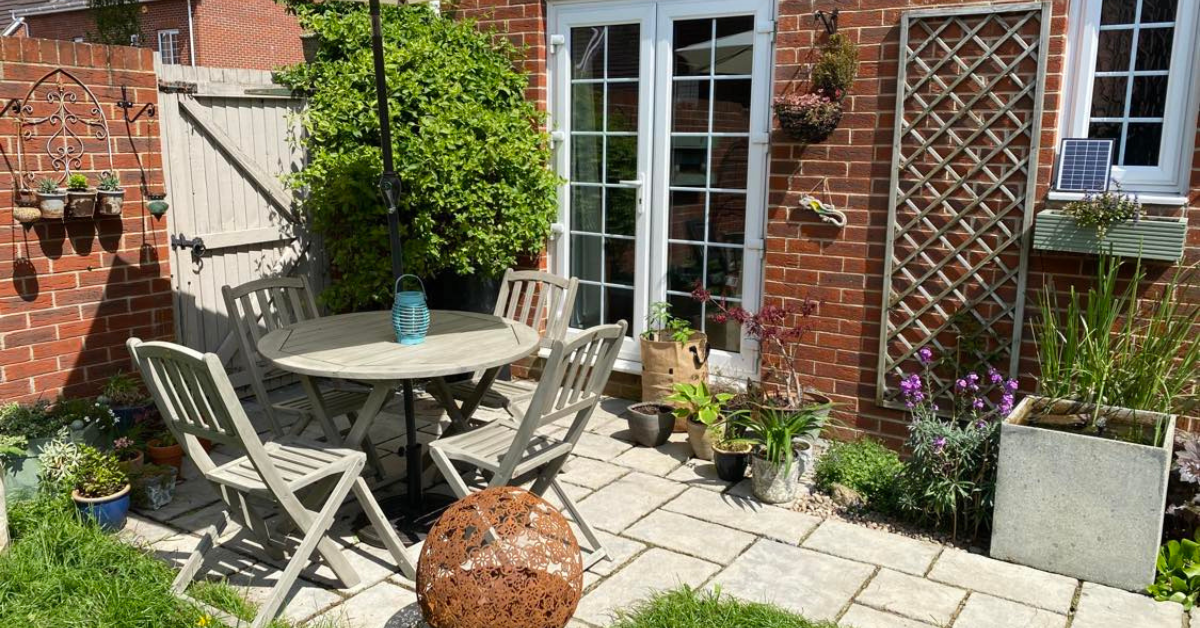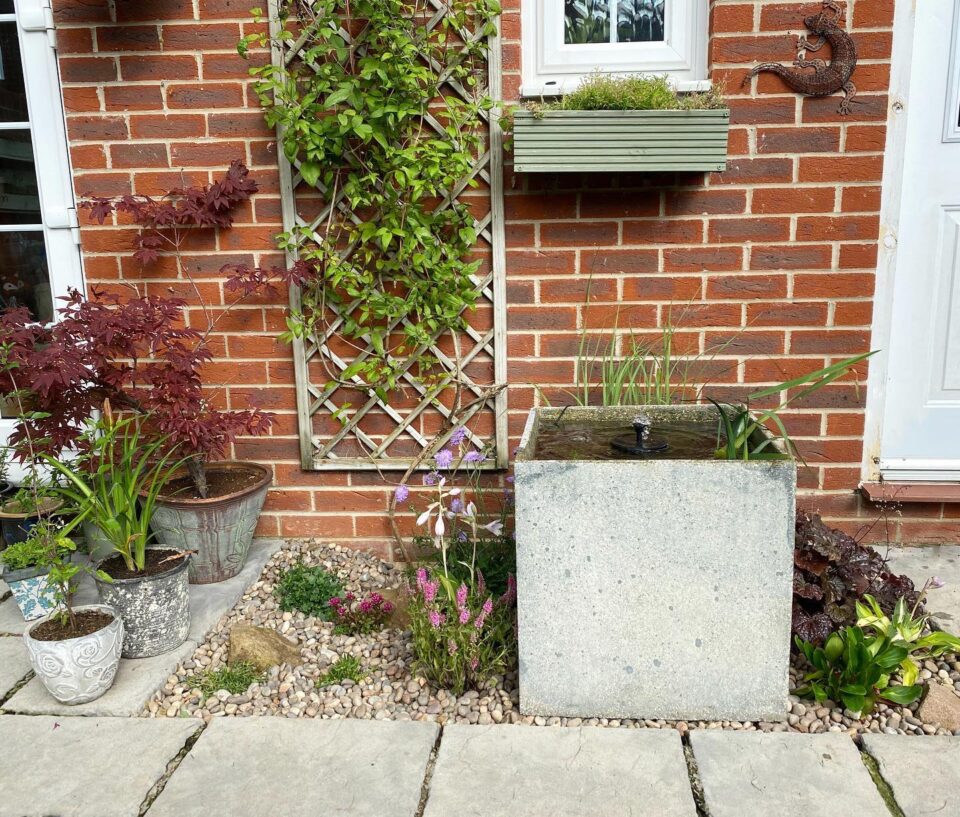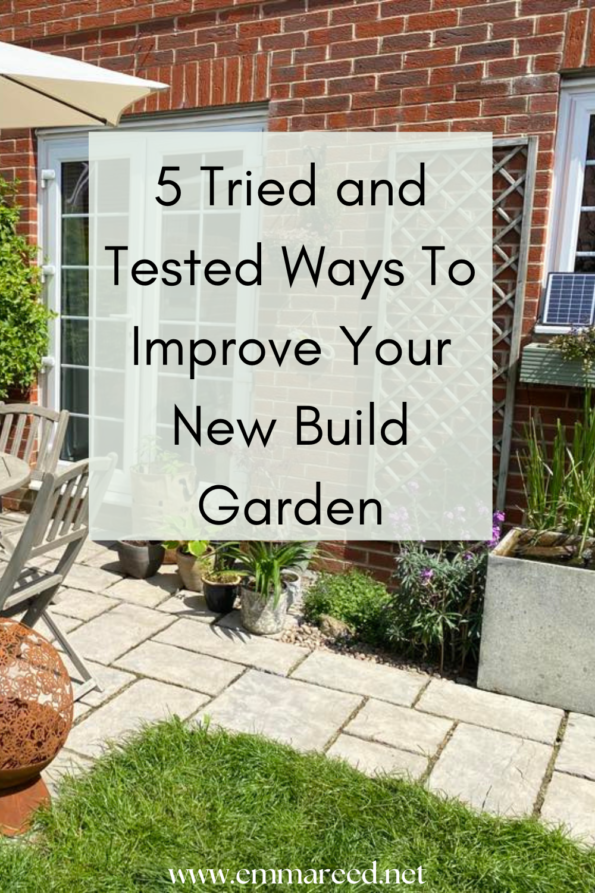
5 Tried and Tested Ways To Improve Your New Build Garden

*Affiliate Links
New build gardens can be tricky to get right. They are notoriously known for being small, lifeless and in very poor condition, I should know, I’ve been there. We spent years dealing with low-quality soil if you can even call it that – it was mostly made up of bricks, stones, plastic pieces, glass and metal, basically whatever had been used on the building site that was then covered over. This led to failed plants and flowers, far too much money being spent and many frustrations. As a novice gardener, I had to learn as I went so I now want to be able to give a little bit of advice and a few tips to help you improve your own new build garden before you fall into the fails that we did.
1. Improve That Soil
If you want a garden that will flourish year after year you have to ensure that your soil is in the best condition it can be. You will want to:
- Dig and turn the soil in your beds to break it up. New build soil is usually heavily compacted
- Remove large bricks/stones/rubbish etc
- Add in a decent peat-free compost such as a soil improver or your own homemade compost
- Turn the new compost in with the existing soil using a fork. Keep going until your soil is clump free, rubbish free and looks well mixed
- Choose plants that are hardy, will provide year-round interest, will return every year (perennial) and can cope with your garden’s particular conditions. As pretty as seasonal flowers do look, if you only choose these you will be spending out time and time again
- Once you have planted up, you can use a mulch or fertiliser to provide your new plants/flowers with the nutrients they need

2. Lawn Care
New build lawns can be a bit hit or miss. Ours was personally pretty good in most places but I have seen some disastrous lawns on social media lately. Again the main problem is going to be your soil. Your best options will be to:
- Plan out your garden and decide if you want to dig in some new beds, add a patio/decking, build a pathway or have stepping stones or if a lawn is right for you (more on this in a moment)
- Once you know which areas of lawn you are keeping, inspect where it is going to need some TLC
- For small issues such as patchy areas, aerate the lawn, sprinkle grass seed and add a good layer of a peat-free compost over the top. Then just wait for the magic to begin. If you see birds coming down to grab a snack you can either use netting or frost fleece to cover and protect the seed
- For bigger issues you may want to consider removing the current lawn, improving the soil as mentioned above and returfing the whole thing
Lawn options:
If a grass lawn isn’t for you then you could consider:
- a clover lawn
- wildflower lawn
- large beds or pot plants surrounded by gravel pathways which could be planted with alpines
- a moss lawn
- a mixture of ground-covering plants and flowers
You may have noticed that I haven’t mentioned artificial (plastic) grass and this is for environmental as well as safety reasons (a plastic lawn, especially in a new build garden will overheat in the warmer months). I have more on alternatives to plastic grass here.
Other lawn issues may well be caused by an ecosystem imbalance such as too many certain types of bugs and according to TikTok these days, leather jackets in particular (the grubs of the crane fly/daddy long legs). I don’t know an awful lot about these but from what I have read, the problem has come about because these new build houses are being built on fields that have forever been used by wildlife, bugs and insects. So inevitably these will either vanish completely or in these insect’s case, continue to use this as a good breeding ground and why not eh? It was their space first after all. The second issue is that we have had a very unusually long wet spell which adds to the deterioration of a grass lawn. To help balance out the ecosystem again you will need to encourage natural predators back into your garden so start feeding the birds, make sure that hedgehogs can easily enter and exit the space (purchase hedgehog highway doors, dig holes under fences) and add a pond to encourage amphibians (see below). I have seen so many videos about digging up entire lawns, adding chemicals, killing the grubs, concreting over and so on but really if we take a natural approach the problem will sort itself out simply and for good.
3. Sectioning
When you have a small garden sectioning is going to be your best friend to maximise on space. I remember when we looked at our house and almost didn’t go for it because of the garden. I had always dreamt of having a pond, growing my own, having beautiful flowers, lots of pots etc and I just didn’t think this garden could provide all of that (we compromised and went for it anyway). However, once I saw how sectioning could work I realised I could have all I wanted even in my tiny garden. I have a patio area with pots and seating, a water feature section with planting around it, a very small greenhouse, a compost bin, a mud kitchen area, a wildlife pond, flower beds, a tree, raised beds for growing my own as well as a grass lawn. It can take some vision, research, taking ideas from garden reno programmes and getting to know your space i.e. seeing where the sun hits at certain times of day, knowing which parts of the garden you enjoy sitting in, thinking about shade for where the children play, but once you get it right you will have an outdoor area you will love to be in.

4. Provide Shade
New build gardens can become hot due to them being very small, the use of a lot of fences and walls preventing air flow, lack of green areas within the estate and too many houses being built in close proximity to one another. To help to overcome this you can use plants, shrubs and trees to your advantage… Which will also help the environment and the wildlife of course. We so often see these aerial images of new build gardens, lacking in personality, greenery, interest and the birds and the bees so it is up to you to make a change for the better. Using the corners of your garden to plant large shrubs or trees will aid in bringing some much needed shade to this space. Now you don’t have to go big, some great medium-sized options would be:
- Japanese Maple
- Hawthorn
- Apple tree
- Rowan tree
- Magnolia
- Small palm trees
- Camellia
- Rhododendron
- Amelanchier
- Viburnum
- Laurel
- Black Elder
Once these begin to grow and take shape you will start to notice the change in the temperature in your garden, you will gain shade when you need it and you will most probably see the wildlife being drawn to it.
5. Add Water
I would have to say that the best thing we did in our new build garden was to add water. Not only does this add interest to any garden but just like above, it helps with temperature control and attracting wildlife back (new builds lack wildlife due to the destruction caused to the pre-existing space and it can take years for this to recover). Now, I know new builds lack space so the options here are to:
- buy or build a small water feature – this could just be a plastic pot with a fountain
- build a pond out of a planter as I did here
- add a small wildlife pond just as I also did here

Yes, even with our postage stamp of a garden we did manage to incorporate two areas with water. One sits next to our patio which not only looks lovely but also helps to cool this area in the summer whilst providing a bath for some of our feathered friends. Our wildlife pond is placed within a flower bed and has allowed more plants/flowers to flourish as it cools the surrounding area plus it attracts insects, bugs, hedgehogs and frogs which has been amazing to see.
I hope this article has given you a little inspiration for your own new build garden and I really hope it brings you as much joy as ours does for us.

*This post contains affiliate links which will not affect your shopping experience but it does mean I will earn a small commission if you shop via them. For more information please refer to my disclosure page.
Pin for later:

If you enjoyed this post you can follow more of our life, opinions and antics over on Facebook, Twitter, YouTube and Instagram. Plus feel free to come and join in with my parenting group ‘From One Parent to Another’ on Facebook.
If you’d like to contact me you can either leave me a comment or drop me a line via my contact me page.
For other topics similar to this one check out these suggestions below…




